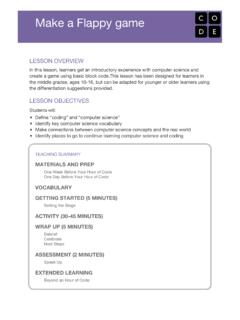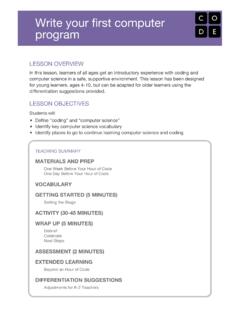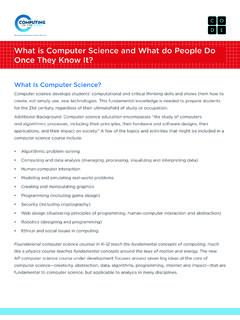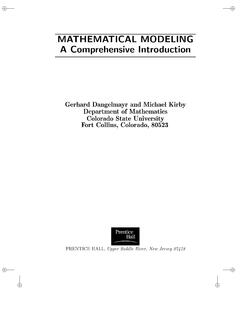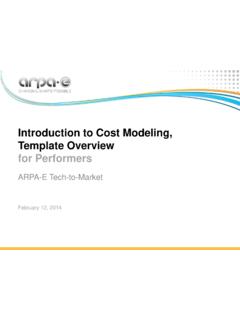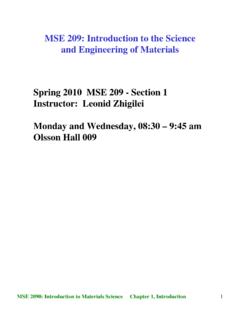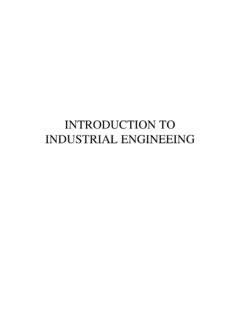Transcription of MODULE 1 (COMPUTER MODELING AND SIMULATION) …
1 MODULE 1: MODELING and simulation 1 MODULE 1 ( computer MODELING AND simulation ) introduction MODULE Name: introduction to computer MODELING and simulation Content of this introduction : 1. Overview of the MODULE 2. Prerequisite knowledge and assumptions encompassed by the MODULE 3. Standards covered by the MODULE 4. Materials needed for the MODULE 5. Pacing Guides for 6 Lessons, including Learning Objectives and Assessment Questions 1. Overview of the MODULE This MODULE introduces basic concepts in MODELING complex systems through hands-on activities and participatory simulations.
2 A scaffolded series of highly-engaging design and build activities guide students through developing their first computer model in StarLogo Nova, a MODELING and simulation environment developed at Massachusetts Institute of Technology. Students practice designing and running experiments using a computer model as a virtual test bed. 2. Prerequisite knowledge and assumptions encompassed by the MODULE There are no prerequisites for MODULE 1. The MODULE was designed to be an introduction to computer MODELING and simulation for students with no prior background in the topic.
3 It is necessary to complete this MODULE prior to commencing the Earth, Life or Physical Science MODULE . 3. Standards covered by the MODULE Please see the Standards Document for a detailed description of Standards covered by this MODULE , Lesson by Lesson. 4. Materials needed for this MODULE You will need the following materials to teach this MODULE : computer and projector What is a CAS? document [for reference] Characteristics of a Complex Adaptive System document [for reference] MODULE 1.
4 MODELING and simulation 2 Feedback Loops document [for reference] Turn and Walk StarLogo Nova models [for Lesson 1 activity] Red, blue, and black pens for students [for Lesson 3 activities] Dice and paper cups for students [for Lesson 4 activities] Guided introduction to StarLogo Nova document [for reference] StarLogo Nova Blocks CS Concepts guide document [for reference & student handout] StarLogo Nova Blocks Reference Guide [for reference & student handout] Scientific Practices with MODELING & simulation [student handout] Experimental Design Form document [student handout] Model observation Form [student handout] Project Design Form [student handout] Model Design Form [student handout] Lesson plans for 6 lessons Slide presentation with instructions New commands and concepts sheets for each lesson [student handout] 5.
5 Pacing Guides for 6 Lessons, including Learning Objectives and Assessment Questions. (See following pages.) MODULE 1: MODELING and simulation 3 DAY 1- introduction to Complex Adaptive Systems and computer MODELING and simulation Pacing Guide Getting Started (Assessment) Pre-test / Assessment- Optional 10 min Activity 1 (New Learning) Turn & Walk: Participatory simulation , computer Model (Teacher-led demo), Correspondence between the real world and the virtual world, and Parts of a StarLogo Nova model.
6 25 min Activity 2 (New Learning) Complex Adaptive Systems: Video introduction , Characteristics of Complex Adaptive Systems. 10 min Wrap up (Reflection) What are computer models good for? 5 min Learning objectives: Students Complex Adaptive Systems Experience being part of a complex adaptive system. (LO 1) Learn characteristics of complex adaptive systems. (LO 6) Learn that complex adaptive systems are 1) made of many interacting parts or agents, 2) each agent follows its own rules, 3) emergent patterns can result from the interaction of agents.
7 MODELING and simulation Compare and contrast a computer simulation vs. a real-world phenomenon. (LO 2) See a demo of using a computer model to run experiments. (LO 3) Speculate as to why computer models can be valuable scientific tools. (LO 5) Learn that models are representations of reality. Not all features of the real world are incorporated in to models. Models contain assumptions. Learn how to setup and run an experiment using a model as a test bed. computer Science Investigate the parts of a StarLogo Nova user interface and paradigm.
8 (LO 4) Learn that programs consist of simple instructions that are executed in a sequence. Each time the instructions are repeated in a loop. Each time through the loop is called an iteration. Assessments of understanding: Complex Adaptive Systems What are four necessary characteristics of complex adaptive systems? [They are 1) made of many interacting parts or agents, 2) each agent follows its own rules, 3) emergent patterns can result from the interaction of agents and 4) hard to predict.] MODELING and simulation Why are models useful?
9 How can computer models be used to learn about the real world? What can be different about a model vs. the world? computer Science What is an instruction? What is a loop? What is an iteration? What are the parts of the StarLogo Nova user interface? MODULE 1: MODELING and simulation 4 DAY 2- introduction to StarLogo NOVA and building Flower Turtles & Painting Turtles Pacing Guide Getting Started (Review) Review of the previous day s lesson and concepts; connection to today s lesson.
10 5 min Activity 1 (Guided Practice) Guided Tour of StarLogo Nova: Guided Tour and Observations and Ethical considerations concerning remixing and sharing. 20 min Activity 2 (Discovery/Creative) Flower Turtles Challenge: Pair programming; new StarLogo Nova commands, and Flower Turtles Challenge with extension. 20 min Wrap up (Reflection) What does Flower Turtles have to do with MODELING and simulation ? 5 min Learning objectives: Students Complex Adaptive Systems Learn that in complex adaptive systems one type of interaction is that agents impact their environment.




